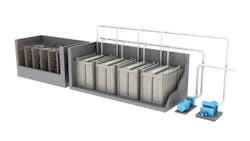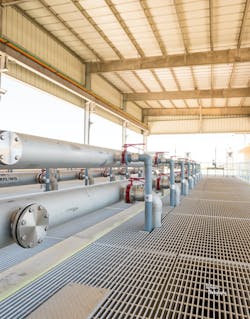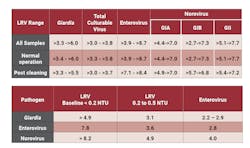Fitting Membrane Bioreactors Into Potable Reuse
About the author:
Steve Katz is a global market development manager for SUEZ – Water Technologies & Solutions. Katz can be reached at [email protected].
In the coming years, surging population growth and escalating water demand will place greater stress on the world’s water resources. With future fresh water shortages expected, many urban communities—and especially those in drought prone regions—face significant challenges in ensuring adequate and reliable potable water supplies.
To enhance water security, more cities are diversifying their supply portfolios by turning to alternative water sources. They are also beginning to shift from a linear model of water management to a more circular approach, prioritizing water reuse over discharge.
Communities, industry and agriculture for many years have reused reclaimed wastewater, industrial process water and agricultural return flows for various non-potable applications. Recycling wastewater for potable purposes is also emerging as a common practice, albeit mostly in areas of significant water stress. However, as water demand rises and water scarcity becomes more widespread, municipalities are expected to increasingly rely on reclaimed wastewater as a reliable and resilient means of supplementing potable supplies.
Central to potable water reuse projects is the design of a treatment train or flowsheet of treatment technologies. These flowsheets with multiple barriers of treatment are designed based on prevailing wastewater characteristics, the end water quality target, regulatory guidelines and most importantly, to protect public health.
Membrane bioreactor (MBR) technology—combining biological, secondary and tertiary wastewater treatment in one process and the gold standard for recycling of wastewater for non-potable applications—presents an attractive option for potable reuse schemes. This is primarily due to its compact footprint, robust pathogen reduction and lower capital and life cycle costs. The biological treatment system of an MBR unit can be optimized for nutrient removal and effluent is disinfected to a level safe for recreational use. Some jurisdictions have even allowed for post-membrane disinfection units to stand idle due to the effluent quality achieved. For advanced reuse applications, the MBR process guarantees an effluent that is free of suspended solids and therefore has a characteristically low silt density index (SDI less than 3) and low turbidity (< 0.2 NTU), making it ideal for direct feed to a reverse osmosis (RO), ozonation, activated carbon or other purification technology.
MBR technology produces a treated effluent that meets the same level of quality of conventional treatment combined with ultrafiltration (UF) or microfiltration (MF). Substituting an MBR system for these treatment steps in a potable reuse flowsheet that also includes RO and an advanced oxidation process (AOP) creates a more simplified and economical treatment train design in a smaller footprint.
Robust Pathogen Removal
Crediting of unit operations for the constituents that they remove becomes critical in this new world and this includes pathogens. While past studies have tended to focus on the treatment of bacterial constituents, such as total coliforms, fecal coliforms and E. coli, an expanding body of published work has emphasized the removal of viruses and protozoa as well as bacteriophages (viruses that infect bacteria). For addressing pathogens, MBR technology has shown to be effective in the treatment of sanitary wastewater. Findings have shown:
- MBR offers substantially higher levels of pathogen removal compared to conventional activated sludge treatment performance.
- Membrane age, seasonal variation and membrane cleaning regimes have a limited impact in terms of MBR pathogen reductions.
- The ability of MBR technology to reduce pathogens is attributed to a variety of mechanisms related to biological treatment and the physical removal of pathogens by the membrane itself.
A 2017 study commissioned by Valley Water and executed by Carollo Engineers investigated pathogen removal at MBR treatment facilities under different cleaning regimens and membrane conditions. Phase 1 of the study involved sampling at two full-scale treatment facilities employing LEAPmbr technology to assess the efficacy of these systems to remove pathogens during normal MBR operation and after cleaning protocols. The MBR’s operational protocols were not adjusted during the study to ensure performance reflected real-world conditions. Results of phase 1 indicated high log reductions of pathogens as every single sample taken over 10 sampling events was below detection limits. This pushed the research team to sample greater quantities of permeate as the study progressed. Figure 1 shows a summary of the log reductions seen across the study.
In phase 2 of the study, sampling was conducted under normal operating conditions as a baseline and then after the membranes were intentionally damaged by fiber cutting to simulate potential breaches of membrane integrity. The test protocol was repeated on consecutive days with a different test module. The objective of the intentional damage was to compromise integrity and increase the system turbidity to levels between 0.15 and 1 NTU. Results showed significant removal of protozoa and viruses under compromised conditions with elevated turbidity. It was also observed that the membrane fibers would heal or plug in less than 15 minutes, returning to turbidity values less than 0.2 NTU. Figure 2 shows log reduction values for pathogens at various ranges of effluent quality.
Gaining Momentum with Potable Reuse Projects
As municipalities of all sizes explore how to best diversify their fresh water supplies, MBR technology is being evaluated and implemented as a primary option in many potable schemes. In Abilene, Texas, the Hamby Water Reclamation Facility is currently the only MBR project in the U.S. providing indirect potable reuse. Completed in 2015, the project was built as a first phase response to chronic drought conditions that had reduced reservoir levels to less than 30% capacity. The upgraded water treatment system enables the city to replenish water levels in Lake Fort Phantom Hill, one of the city’s key reservoirs. The MBR system provides the cornerstone of the city of Abilene’s recycling program. A portion of the treated effluent is currently being used for non-potable uses. The other portion is further treated for reservoir augmentation by a split stream of RO and ozone followed by biofiltration and lastly, chlorine disinfection after the stream is recombined. The facility was approved by the Texas Commission on Environmental Quality and has recently completed an expansion to be able to treat a daily maximum flow of 27 million gallons per day.
A mega potable reuse project slated to include MBR technology is the Public Utilities Board (PUB) of Singapore’s Tuas Water Reclamation Plant (WRP), which will mark the transition of NEWater facilities from conventional activated sludge and ultrafiltration to MBR. When the Tuas WRP is completed in 2025, it will represent the largest MBR plant in the world. In building the Tuas WRP, PUB is intent on creating the most energy efficient MBR system in the world. To that end, PUB in 2017 established the Ulu Pandan Wastewater Treatment Demonstration Plant to test advanced water treatment technologies and process schemes before they are deployed on a larger scale.
In Southern California, several large potable reuse projects incorporating MBR technology are in the works. The Regional Recycled Water Program, a partnership between the Metropolitan Water District of Southern California and the Sanitation Districts of Los Angeles County, would purify wastewater to produce high quality water for reuse, is a prime example. The program is underway with a demonstration facility—the Advanced Purification Center—that employs a three-step purification process of MBR, RO and UV advanced oxidation to create high quality, purified water supporting the agency’s public outreach program and the regulatory elements of the project. Once approved, the full-scale regional recycled water program would produce up to 150 million gallons of purified water per day for replenishing groundwater basins. Purified water could also be delivered to industrial facilities and potentially as direct potable reuse to metropolitan’s water treatment plants and delivery system.
A prominent example of MBR technology supporting indirect potable water reuse for smaller communities is seen in the city of Morro Bay, located on California’s central coast. To meet state and federal requirements and ensure a sustainable water future, the city is replacing its existing wastewater treatment plant with an advanced water purification facility capable of providing up to 80% of the city’s future water needs. The water reclamation facility will incorporate MBR followed by RO and advanced oxidation to produce purified water for aquifer injection, supplementing the city’s groundwater supply.
At a societal level, we are being pushed to look at the world differently. As we realize that all water is recycled water and that no “new” water exists and that the technology is here to improve any quality of water to any desired final product, more communities will prioritize the recycling of what was known as wastewater to augment potable water supplies. Treatment technology plays a vital role in this paradigm. With a robust pathogen barrier and a compact footprint to more readily fit within existing infrastructure, more municipalities are recognizing MBRs as a cost-efficient and dependable technology for supporting advanced water recycling schemes and creating more resilient water supplies.


